Discover 35 hidden attractions, cool sights, and unusual things to do in Aachen (Germany). Don't miss out on these must-see attractions: Aachen Cathedral, City Hall, and Vaalserberg. Also, be sure to include Statue of Charlemagne in your itinerary.
Below, you can find the list of the most amazing places you should visit in Aachen (North Rhine-Westphalia).
Table of Contents
Aachen Cathedral
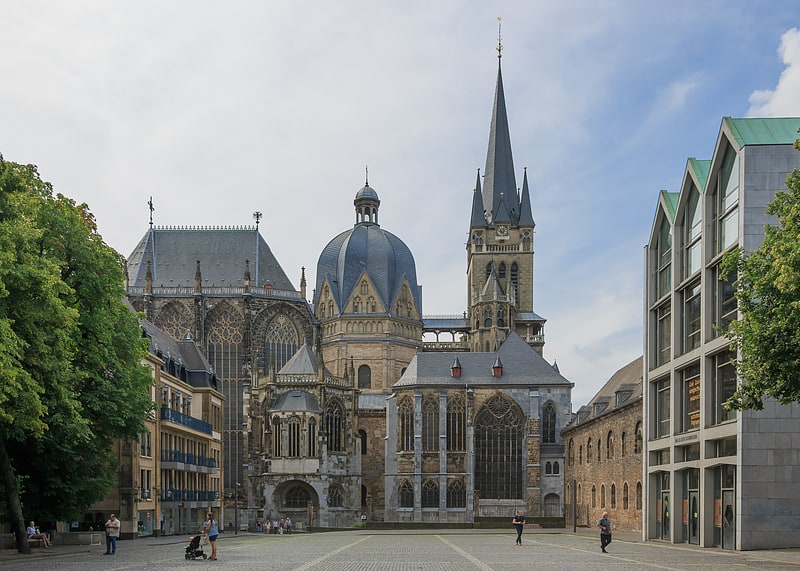
Also known as: Aachener Dom
Iconic cathedral and Charlemagne's chapel. Aachen Cathedral,a Roman Catholic church in Aachen, Germany and the seat of the Roman Catholic Diocese of Aachen.
One of the oldest cathedrals in Europe, it was constructed by order of Emperor Charlemagne, who was buried there in 814. From 936 to 1531, the Palatine Chapel saw the coronation of thirty-one German kings and twelve queens. The church has been the mother church of the Diocese of Aachen since 1930.[1]
Address: Klosterplatz 2, 52062 Aachen (Aachen Mitte)
City Hall
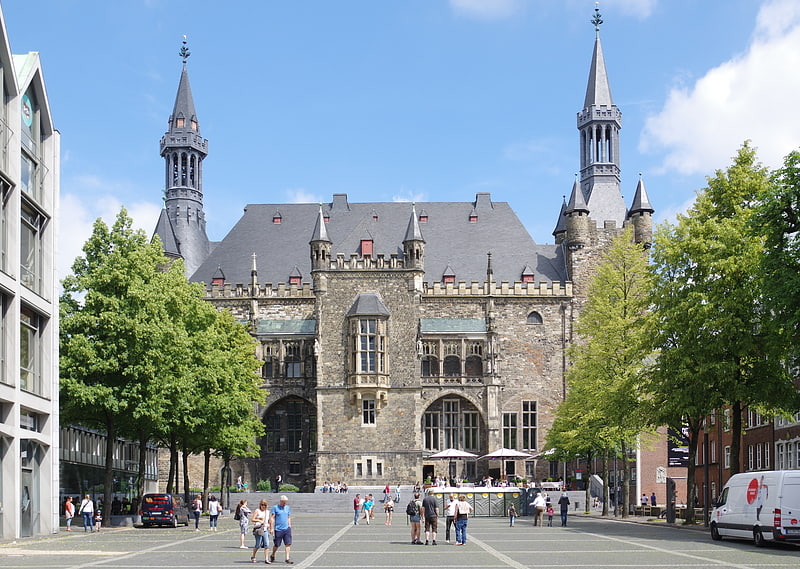
Also known as: Aachener Rathaus
Town hall hosting replica crown jewels. Aachen Town Hall is a landmark of cultural significance located in the Altstadt of Aachen, Germany. It was built in the Gothic architecture style in the first half of the 14th century.[2]
Address: Markt 1, Aachen (Aachen Mitte)
Vaalserberg
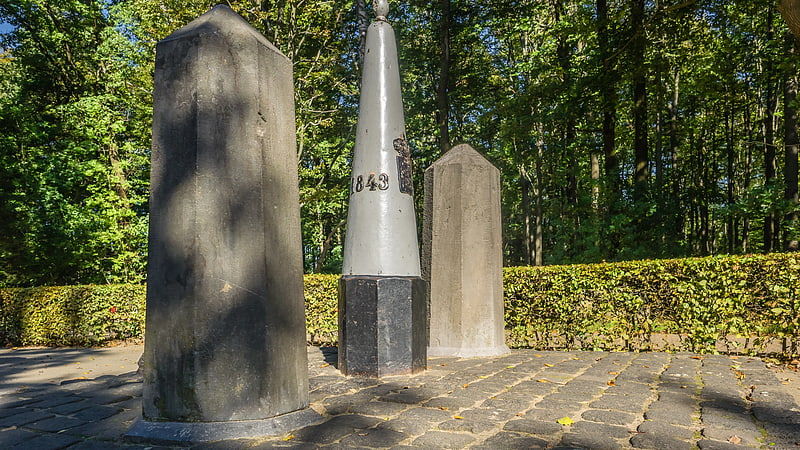
Hill in Belgium. The Vaalserberg is a mountain with a height of 322.4 metres above NAP and is the highest point in the European part of the Netherlands, also known as "Dutch Mountains". The Vaalserberg is located in the province of Limburg, at the south-easternmost edge of the country, near the town of Vaals.
Mount Scenery on the island of Saba, which is in the Caribbean part of the Netherlands, replaced Vaalserberg as the highest point in the Netherlands, following the dissolution of the Netherlands Antilles in 2010.[3]
Address: Viergrenzenweg 97, 6291 BM Aachen
Statue of Charlemagne
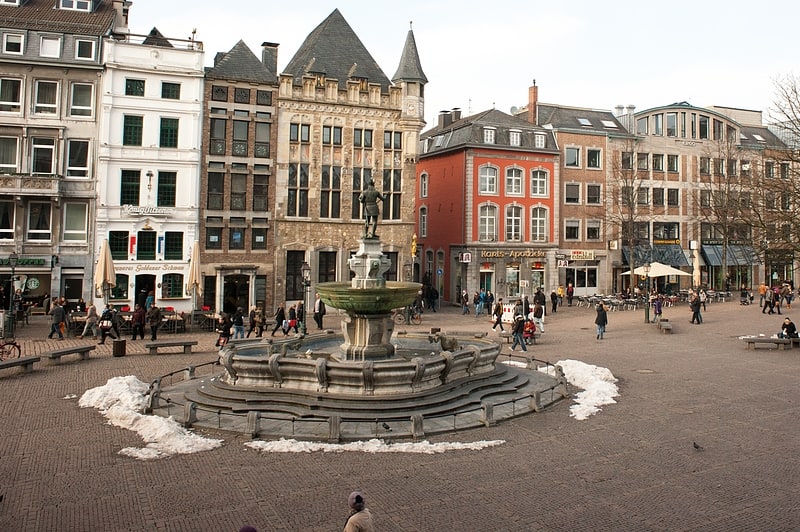
The statue of Charlemagne is a prominent public sculpture representing Charlemagne in Aachen. It was first erected in 1620 on the Marktplatz in front of Aachen Town Hall, as part of the monumental Karlsbrunnen fountain. The statue now standing on the Karlsbrunnen is a 1969 copy, and the original has been kept since 2014 at the nearby Centre Charlemagne museum. It has become the most popular image of Charlemagne in the monarch's chosen capital of Aachen.[4]
Ponttor

Imposing, 14th-century city gate. The Ponttor in Aachen, Germany, is one of the two remaining gates of the original city wall of Aachen. The westernmost of the north-facing gates, the Ponttor was built in the 14th century and manned by soldiers and militia throughout the Free Imperial City of Aachen era. Today, the Ponttor is used by German Youth and Scout groups belonging to the German Scout Club and the German Scout Association Saint George.[5]
Address: Ruetscher Str. 4, 52072 Aachen (Aachen Mitte)
Suermondt-Ludwig-Museum
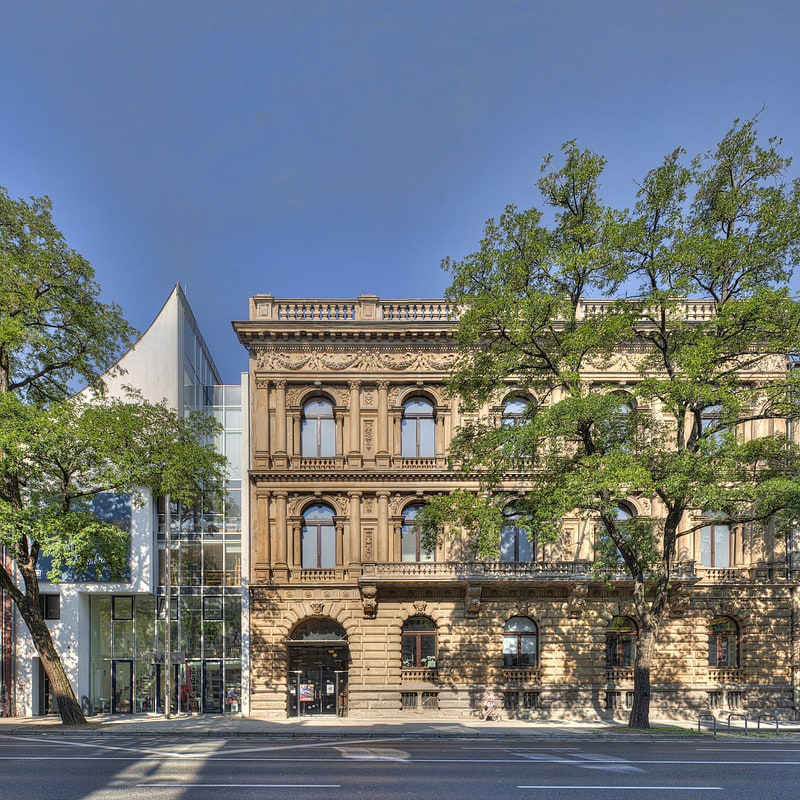
Museum in Aachen, Germany. The Suermondt-Ludwig-Museum is an art museum in Aachen, Germany. Founded in 1877, its collection includes works by Aelbrecht Bouts, Joos van Cleve, Anthony van Dyck, Otto Dix and Max Beckmann.[6]
Address: Wilhelmstraße 18, 52070 Aachen (Aachen Mitte)
Frankenberg Castle
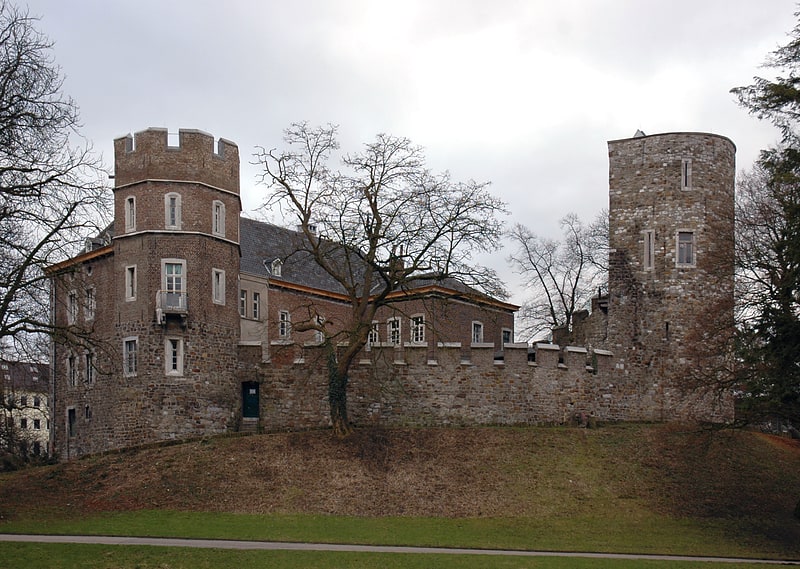
Also known as: Burg Frankenberg
The Frankenberg Castle is a castle in the Frankenberg area of Aachen-Mitte, itself a district of Aachen, Germany. Its name comes from the concept of a “Franke”, which was a type of castle that did not owe fealty to any others. Of course, shortly after its construction, the lowland castle became a fief of a Graf, and later belonged to the Duchy of Jülich-Cleves-Berg.
From 1961 until August 2010 the former water castle housed a museum that documented the history of the Aachen area, from its Stone Age flint mines, through the Roman thermal bath period, up to the Industrial Revolution.[7]
Address: 45 Goffartstraße, Aachen (Aachen Mitte)
Palatine Chapel
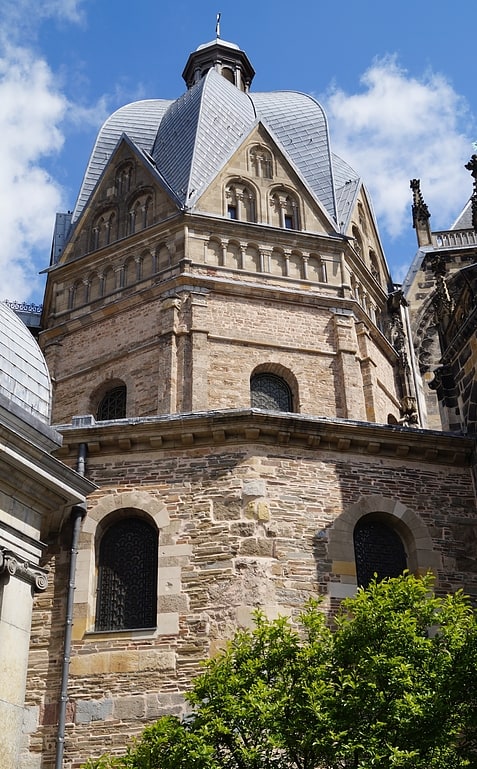
Chapel. The Palatine Chapel in Aachen is an early medieval chapel and remaining component of Charlemagne's Palace of Aachen in what is now Germany. Although the palace itself no longer exists, the chapel was preserved and now forms the central part of Aachen Cathedral. It is Aachen's major landmark and a central monument of the Carolingian Renaissance. The chapel held the remains of Charlemagne. Later it was appropriated by the Ottonians and coronations were held there from 936 to 1531.
As part of Aachen Cathedral, the chapel is designated as a UNESCO World Heritage Site.[8]
Tivoli

Stadium in Aachen, Germany. Tivoli is a football stadium in the Sport Park Soers in Aachen, Germany, that opened on 17 August 2009 replacing the Old Tivoli nearby. It hosts the home matches of Alemannia Aachen in the Regionalliga West. The stadium has a capacity of 32,960 spectators – space for 11,681 standing spectators and 19,345 seats. The seating capacity for international games is set at 27,250.
The city first suggested the new stadium should be built outside the city, near the local airport. However, fans wanted the stadium built within the city. After much debate, plans were released in February 2007, showing that the new stadium would be built in Sportpark Soers, the sporting area the previous stadium was in.
About €4.2 million of the construction costs were financed by bonds mainly targeted at supporters of Alemannia Aachen.
The first match in the new stadium was against the Belgian team Lierse SK, but it was closed for the public. The first Bundesliga-match took place on 17 August 2009 against FC St. Pauli which Aachen lost 0–5, which was the highest home-defeat in Aachen's history.
The first international match was on 4 September 2009 when the Germany national under-21 football team played their first match of the 2011 UEFA European Under-21 Football Championship qualification against San Marino, which they won 6–0.[9]
Address: Krefelder Str. 205, 52070 Aachen (Aachen Mitte)
Ludwig Forum für Internationale Kunst
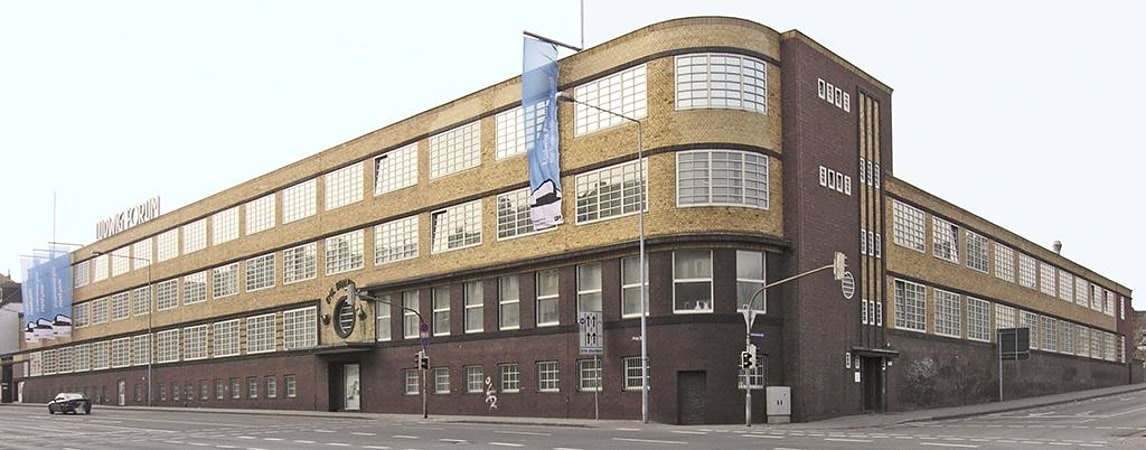
Museum showcasing modern and pop art. The Ludwig Forum for International Art is a museum for modern art in Aachen. It is based on the Ludwig Collection, which was brought together by the Aachen collector couple Irene and Peter Ludwig, and is supported by the Peter and Irene Ludwig Foundation.[10]
Address: Jülicher Str. 97-109, 52070 Aachen (Aachen Mitte)
Kornelimünster Abbey
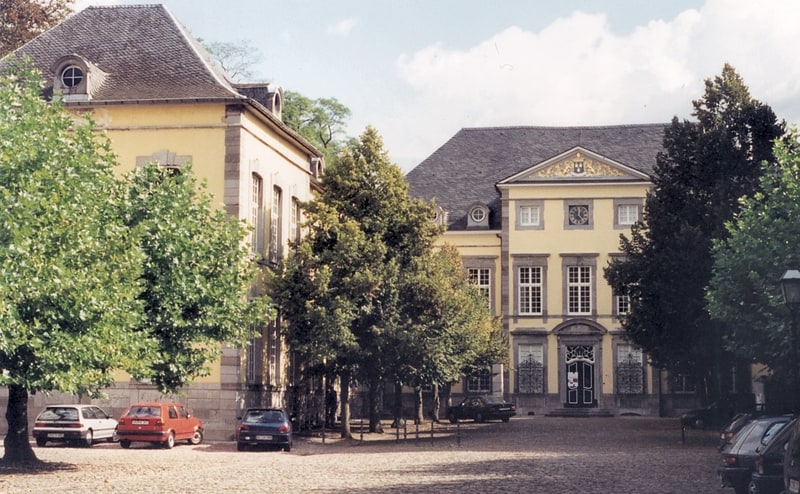
Also known as: Kornelimünster/Walheim
Monastery in Germany. Kornelimünster Abbey, also known as Abbey of the Abbot Saint Benedict of Aniane and Pope Cornelius, is a Benedictine monastery that has been integrated since 1972. The abbey is located in Aachen in North Rhine-Westphalia in Germany.[11]
Address: 20 Schulberg, Aachen (Kornelimünster Walheim)
Throne of Charlemagne
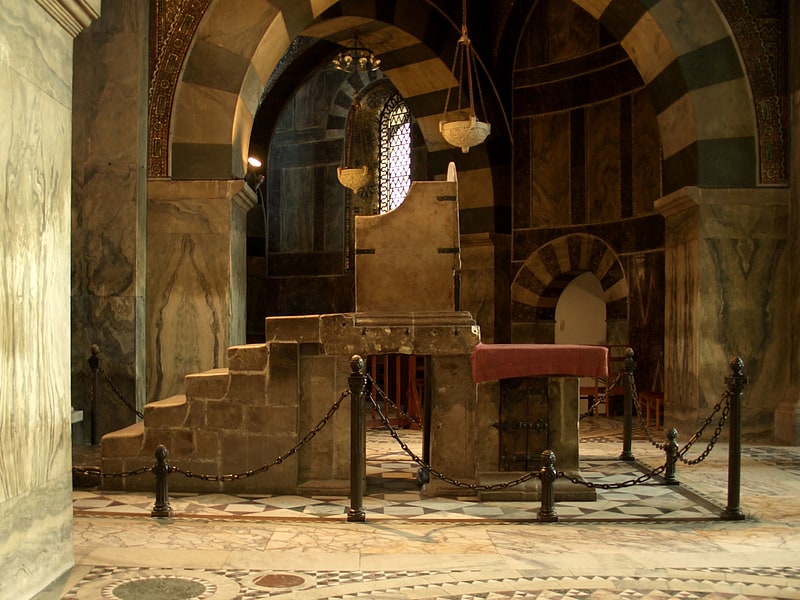
Also known as: Aachener Königsthron
The Throne of Charlemagne is a throne erected in the 790s by Charlemagne, as one of the fittings of his palatine chapel in Aachen and placed in the Octagon of the church. Until 1531, it served as the coronation throne of the Kings of Germany, being used at a total of thirty-one coronations. As a result, especially in the eleventh century, it was referred to as the totius regni archisolium. Charlemagne himself was not crowned on this throne, but instead in the Old St. Peter's Basilica in Rome by Pope Leo III in 800 AD.[12]
Address: Katschhof 1, 52062 Aachen (Aachen Mitte)
Aachen Cathedral Treasury
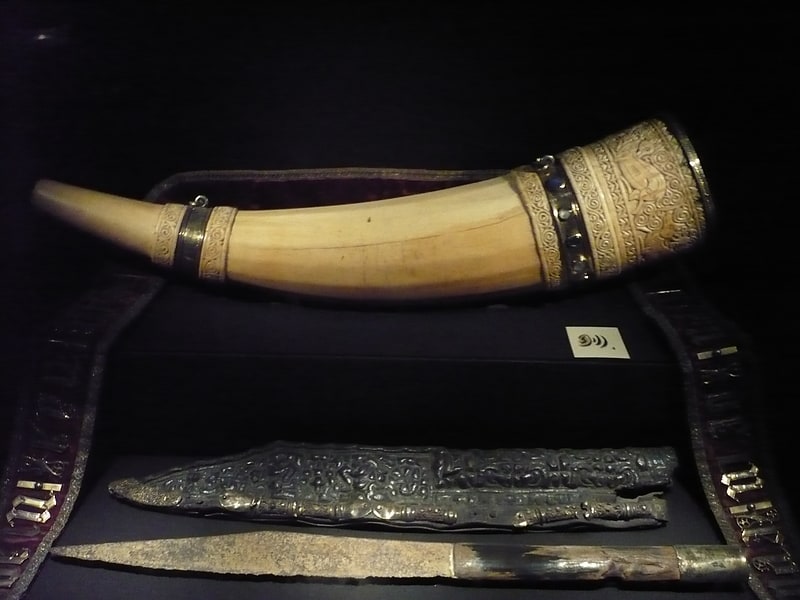
Also known as: Aachener Domschatzkammer
Museum in Aachen, Germany. The Aachen Cathedral Treasury is a museum of the Roman Catholic Diocese of Aachen under the control of the Cathedral chapter, which houses one of the most important collections of medieval church artworks in Europe. In 1978, the Aachen Cathedral Treasury, along with Aachen Cathedral, was the first monument on German soil to be entered in the List of UNESCO World Heritage Sites. The Treasury contains works from Late Antique, Carolingian, Ottonian, Staufen, and Gothic times. The exhibits are displayed in premises connected to the Cathedral cloisters.[13]
Address: Johannes-Paul-II-Strasse,52062 Aachen, Aachen (Aachen Mitte)
Theater Aachen
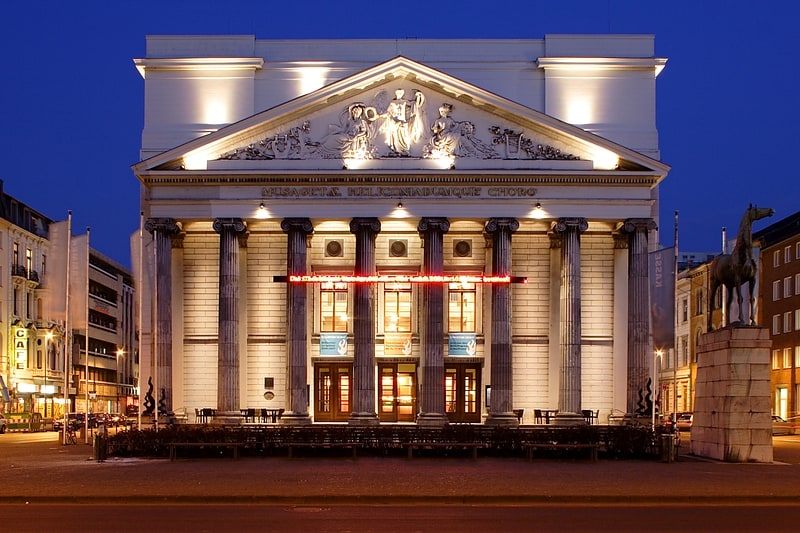
Theatre in Aachen, Germany. Theater Aachen is a theatre in Aachen, Germany. It is the principal venue in that city for operas, musical theatre and plays. It is the home of the Aachen Symphony Orchestra. Construction on the original theatre began in 1822 and it opened on 15 May 1825. A bomb attack on 14 July 1943 destroyed the first theatre, and the current structure was inaugurated on 23 December 1951 with a performance of Richard Wagner's Die Meistersinger von Nürnberg.[14]
Address: Stadttheater und Musikdirektion Aachen, 52064 Aachen (Aachen Mitte)
St. Michael's Church

Also known as: St. Michael
St. Michael's is a church in Aachen, Germany. It was built as a church of the Aachen Jesuit Collegium in 1628, later it was a Catholic parish church and is now a church of the Greek Orthodox Metropolis of Germany. The official name today is Church of Archangel Michael – St Dimitrios.[15]
Address: Jesuitenstr. 6, Aachen (Aachen Mitte)
Karlsschrein
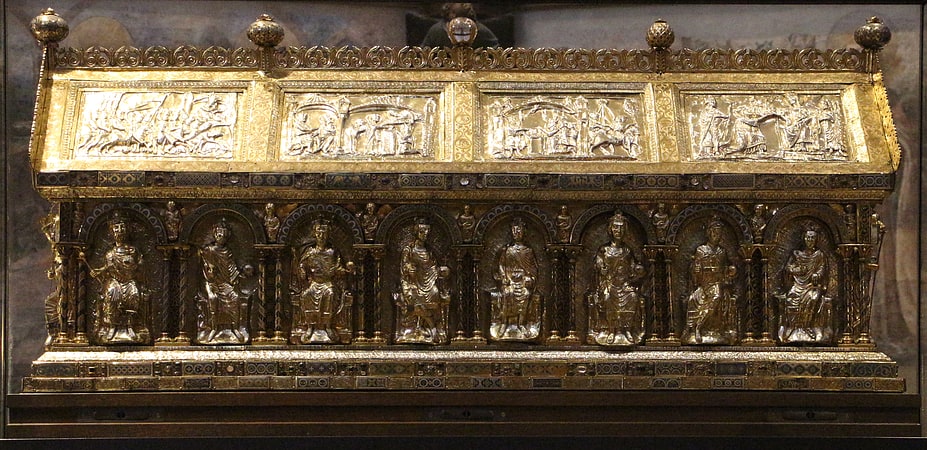
The Karlsschrein is located in Aachen Cathedral and contains the remains of Charlemagne. It was completed in 1215 in Aachen at the command of Frederick II, Holy Roman Emperor. Previously, Charlemagne's remains had been in the Palatine Chapel part of the cathedral until 1165, when Frederick Barbarossa placed the remains in a sarcophagus beneath the floor of the cathedral.
Frederick II personally carried out the transfer of the bones and the sealing of the shrine on 27 July 1215, the first anniversary of the Battle of Bouvines, which had spurred him to seek the German throne. Two days before, he had been crowned again and finally as the King of the Romans at Aachen.[16]
Address: Katschhof 1, 52062 Aachen (Aachen Mitte)
Belvedere Water Tower
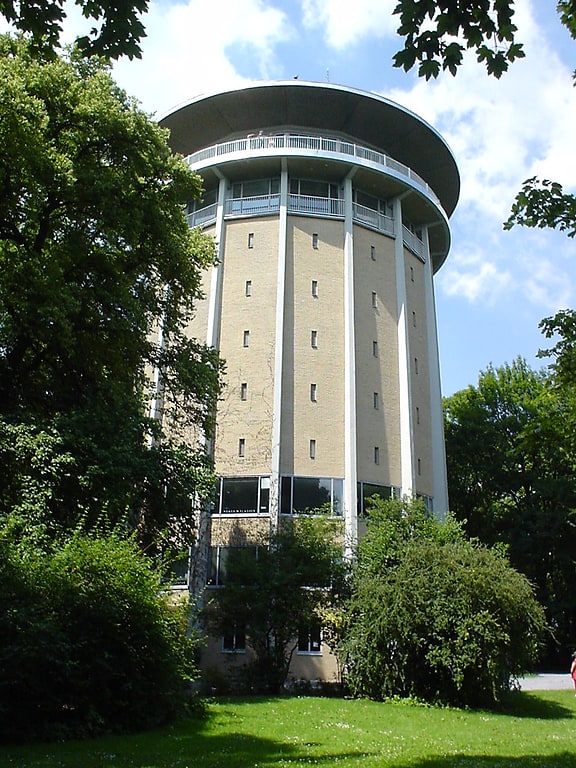
Also known as: Wasserturm Belvedere
The Water Tower Belvedere is a water tower of reinforced concrete construction in Aachen, Germany, located on the Lousberg hill. It was built in 1956.
The water tower accommodates a revolving restaurant, which reopened in 2005 after being closed for several years (it closed again for one year, but was reopen again in 2012). The restaurant revolves once every 56 minutes. Service includes a restaurant, a beer garden and a traditional Sunday brunch.[17]
Address: 5 Belvedereallee, Aachen (Aachen Mitte)
Couven-Museum
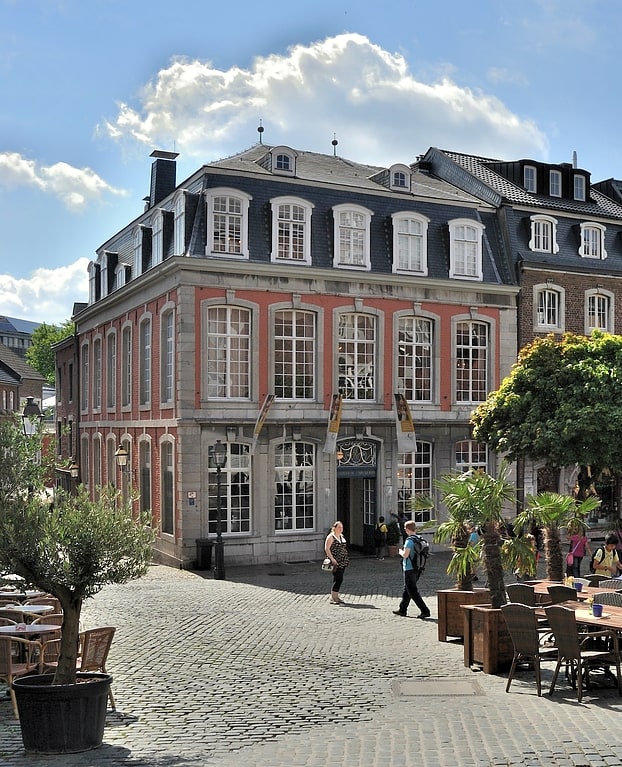
Haus Monheim is a listed building in the old town of Aachen. It was a residential and commercial building of the Monheim family of pharmacists and is one of Jakob Couven's surviving works in Aachen. Today, it houses the Couven Museum and is listed as an architectural monument in Aachen's list of monuments.
Address: Hühnermarkt 17, 52062 Aachen (Aachen Mitte)
Öcher Schängche
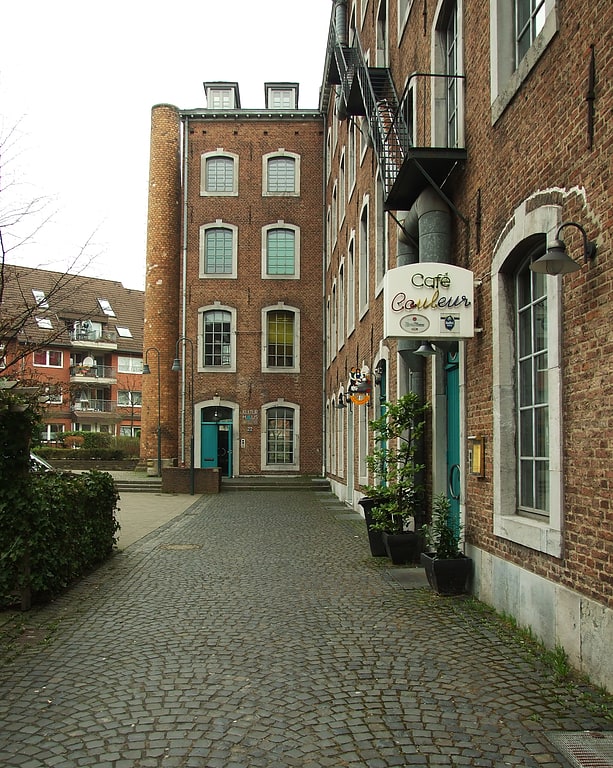
Theatre in Aachen, Germany. Öcher Schängche is a puppetry theatre in Aachen, North Rhine-Westphalia, Germany. It was founded by Will Hermanns and others in 1921.[18]
Westpark

Park in Aachen, Germany. The Westpark is a park in the west of Aachen, which is bounded by Gartenstraße, Welkenrather Straße and Vaalser Straße.[19]
Address: Vaalser Str., 52074 Aachen (Aachen Mitte)
Antoniuskapelle
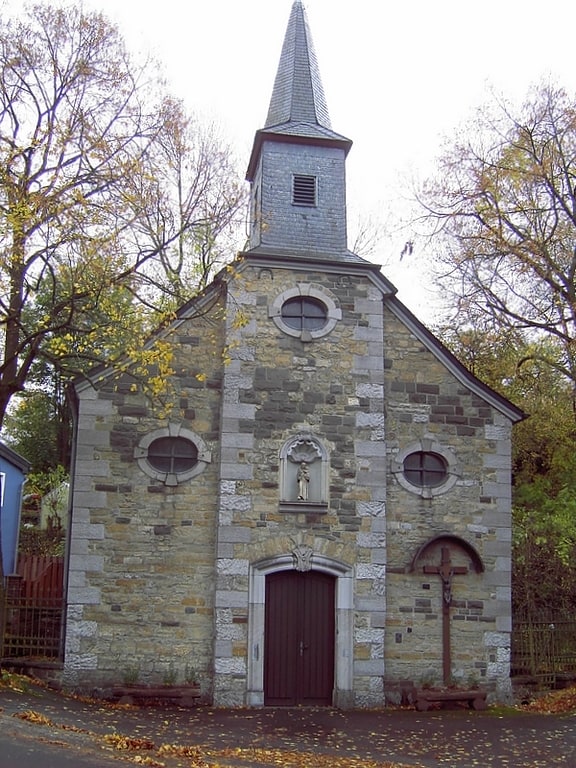
Chapel in Aachen, Germany. St. Anthony's Chapel is located in Kornelimünster/Walheim, a district of the German city of Aachen.
The chapel was built in 1718 but destroyed by an earthquake before consecration. Charles Ludwig von Sickingen-Ebernburg, the abbot of the abbey at Kornelimünster later ordered to rebuild the damaged unfinished building. The work was completed in 1781 and the chapel consecrated in the same year to Anthony of Padua by the administrator of the abbey Charles Caspar von der Horst.
The St. Anthony-Chapel is part of a circle of five chapels built around the abbey as the central church of Kornelimünster.[20]
Address: Kapellenberg 2, 52076 Aachen (Kornelimünster Walheim)
Bismarck Tower
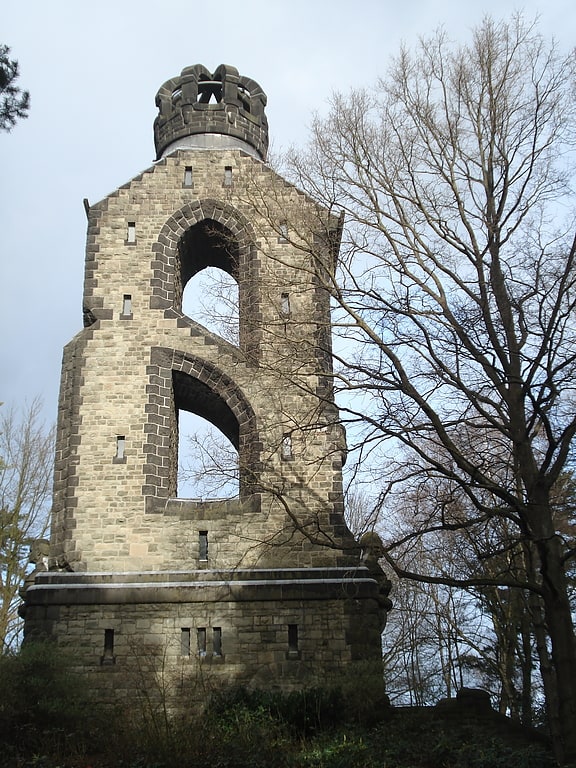
Also known as: Bismarckturm
Tower in Aachen, Germany. The Aachen Bismarck Tower is one of 173 still-standing towers and columns, which were constructed in the German Empire to commemorate the founder of the German state, Otto von Bismarck.[21]
Address: Monschauer Straße, Aachen (Aachen Mitte)
Cross of Lothair

Also known as: Lotharkreuz
Work of art. The Cross of Lothair or Lothair Cross is a crux gemmata processional cross dating from about 1000 AD, though its base dates from the 14th century. It was made in Germany, probably at Cologne. It is an outstanding example of medieval goldsmith's work, and "an important monument of imperial ideology", forming part of the Aachen Cathedral Treasury, which includes several other masterpieces of sacral Ottonian art. The measurements of the original portion are 50 cm height, 38.5 cm width, 2.3 cm depth.
The cross comes from the period when Ottonian art was evolving into Romanesque art, and the engraved crucifixion on the reverse looks forward to the later period.[22]
International Newspaper Museum
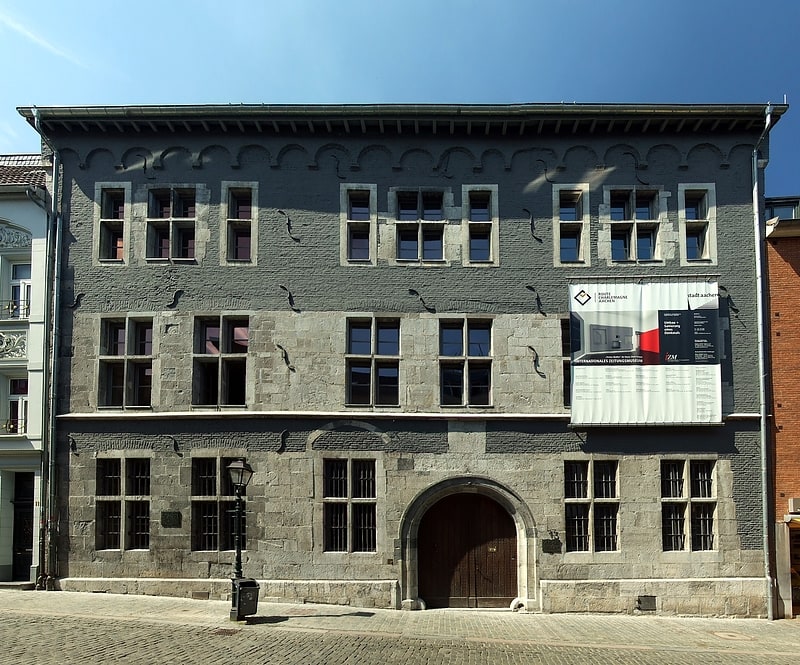
The International Newspaper Museum in Aachen presents the history of newspapers and the subject of press history.
Address: 13 Pontstraße, Aachen (Aachen Mitte)
Marienschrein
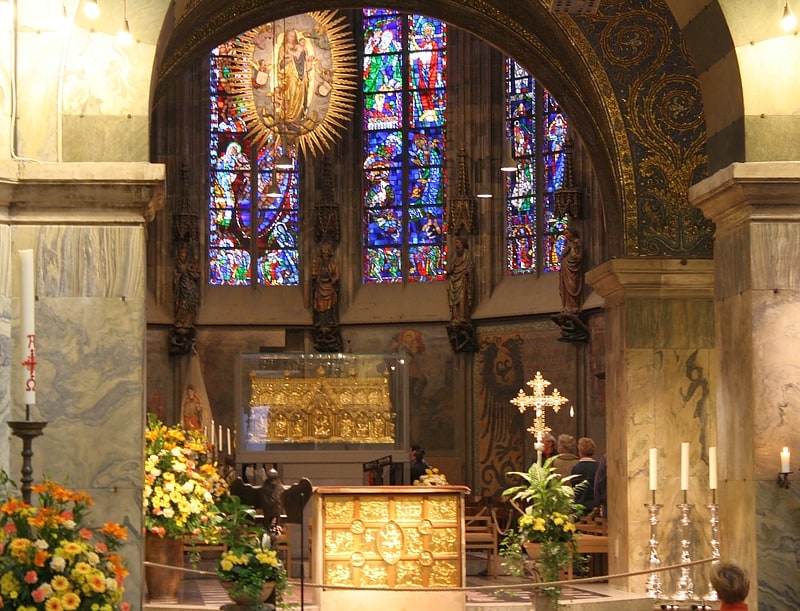
Artwork. The Marienschrein in Aachen Cathedral is a reliquary, donated on the order of the chapter of Mary around 1220 and consecrated in 1239. Along with the Karlsschrein, the artwork, which is from the transitional period between romanesque and gothic, is among the most important goldsmith works of the thirteenth century.[23]
RWTH Aachen University

Also known as: RWTH Aachen
Public university in Aachen, Germany. RWTH Aachen University or Rheinisch-Westfälische Technische Hochschule Aachen is an elite German public research university located in Aachen, North Rhine-Westphalia, Germany. With more than 47,000 students enrolled in 144 study programs, it is the largest technical university in Germany.
RWTH Aachen in 2019 emerged successfully from the final of the third federal and state excellence strategy. The university will be funded as a university of excellence for the next seven years. RWTH Aachen was already part of the federal and state excellence initiative in 2007 and 2012.
Since 2007, RWTH Aachen has been continuously funded by the DFG and the German Council of Science and Humanities as one of eleven (previously nine) German Universities of Excellence for its future concept RWTH 2020: Meeting Global Challenges and the follow-up concept The Integrated Interdisciplinary University of Science and Technology: Knowledge, Impact, Networks, also receiving grants for associated graduate schools and clusters of excellence. The university regularly accounts for the highest amount of third-party funds among all German universities, placing first per faculty member and second overall in the most recent survey from 2018.
RWTH Aachen is a founding member of IDEA League, a strategic alliance of five leading universities of technology in Europe, as well as its German counterpart TU9. It is also a member of DFG and the Top Industrial Managers for Europe network.[24]
Würselen

Town in Germany. Würselen is a town in the borough of Aachen, in North Rhine-Westphalia, Germany.[25]
Aachener Tierpark Euregiozoo
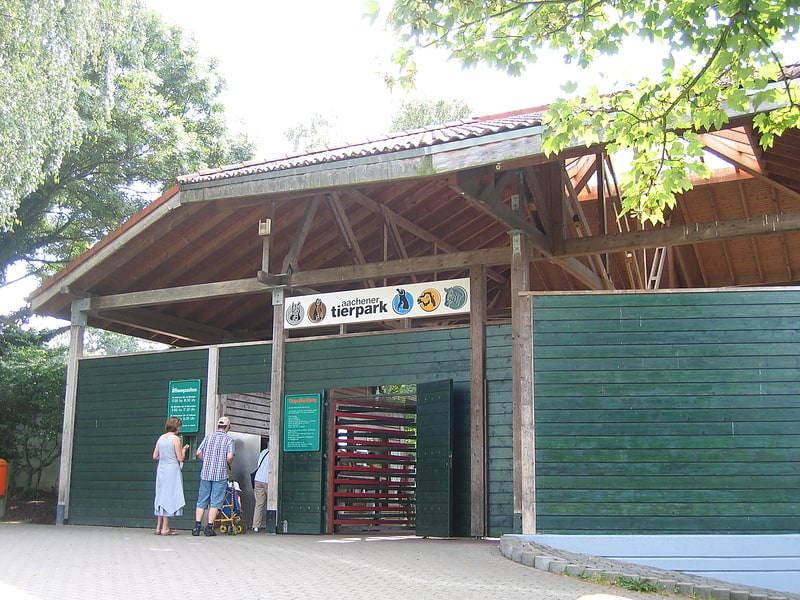
The Aachen Zoo Euregiozoo is an 8.9-hectare zoo located between the districts of Forst and Beverau in Aachen's "Drimborner Wäldchen", named after the former family of aldermen mayors Hermann von Dremborn and Johann von Drimborn. The entrance is located in the Obere Drimbornstraße.
It is flowed through by the Beverbach, which is dammed in the northwestern part of the park to form a lake of about 2 hectares. In 2007, the zoo was accepted into the Association of Zoological Gardens, which only scientifically managed zoos with strict species protection guidelines and breeding programs can join.
Address: Obere Drimbornstr. 44, 52066 Aachen (Aachen Mitte)
Herz-Jesu
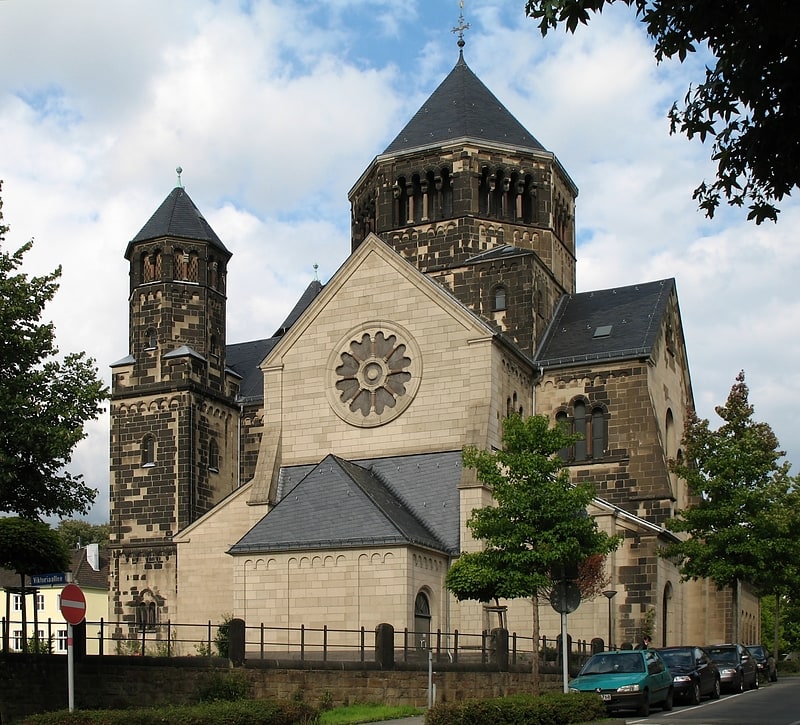
The Catholic Church of the Sacred Heart, colloquially known as Frankenberg Cathedral or Öcher Sacre Coeur, was built between 1908 and 1910 as a neo-Romanesque ashlar basilica designed by architect Josef Kleesattel in the Frankenberg quarter of Aachen's Burtscheid district. The mosaic above the altar is the second largest in the Aachen diocese after the one in Aachen Cathedral.
Address: Viktoriaallee 55, 52066 Aachen (Aachen Mitte)
CHIO Aachen

Sports complex in Aachen, Germany. The CHIO Aachen is a popular international horse show held in Aachen, Germany, each summer.[26]
Address: Albert-Servais-Allee 50, 52070 Aachen (Laurensberg)
St. Foillan
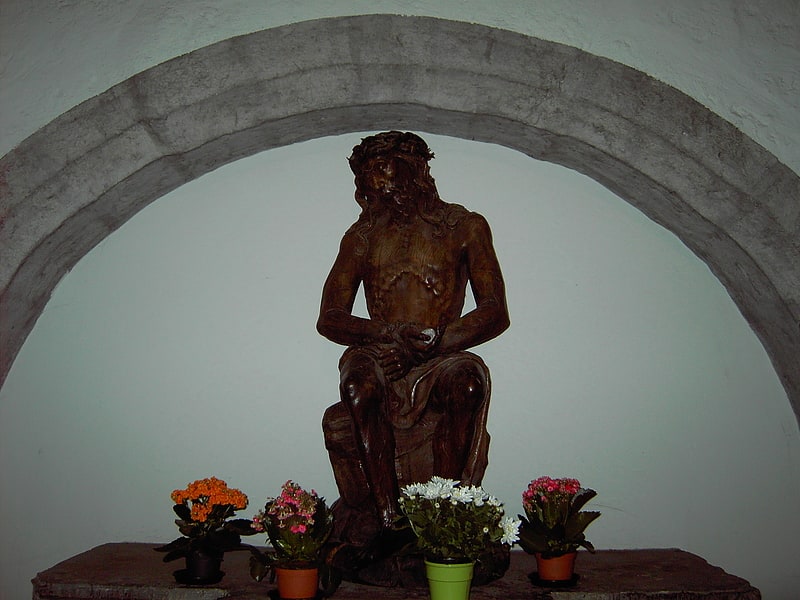
St. Foillan is one of the city parish churches in Aachen. It is located in the area of the pedestrian zone and is separated from the cathedral only by a narrow alley. It is the only church in the German-speaking area which was placed under the patrocinium of Foillan. This is considered an indication that the missionization of the Aachen area came from the west.
Address: Ursulinerstraße 1, 52062 Aachen (Aachen Mitte)
Stadtgarten

The Stadtgarten Aachen with the central and 193 m above sea level Wingertsberg is a landscaped urban park in Aachen. It is composed of the hospital garden created in 1852, which was redesigned as a spa park from 1916, as well as the adjoining Farwickpark to the north and acquired since 1925 and the former Protestant cemetery Güldenplan incorporated after 1945. The city garden has a total area of about 2.3 hectares and is located in the area between Monheimsallee, Jülicher Straße, Robensstraße, Passstraße and Rolandstraße.
The entire Aachen city garden has been listed as a garden monument since 1995 due to its cultural and garden historical significance.
Proserpina sarcophagus

Also known as: Proserpina-Sarkophag
The Proserpina sarcophagus is a Roman marble sarcophagus from the first quarter of the third century AD, in which Charlemagne was probably interred on 28 January 814 in Aachen cathedral. It is displayed today in the Aachen Cathedral Treasury.[27]
St. Adalbert

The Provost Church of St. Adalbert in Aachen was the collegiate church of a collegiate foundation and was consecrated in 1005. It is thus the second oldest church in the city after Aachen Cathedral. St. Adalbert is located directly on today's Kaiserplatz and is dedicated to Adalbert of Prague, who was canonized in 999.
Address: Adalbertstift 1-3, 52062 Aachen (Aachen Mitte)
Grabeskirche St. Josef
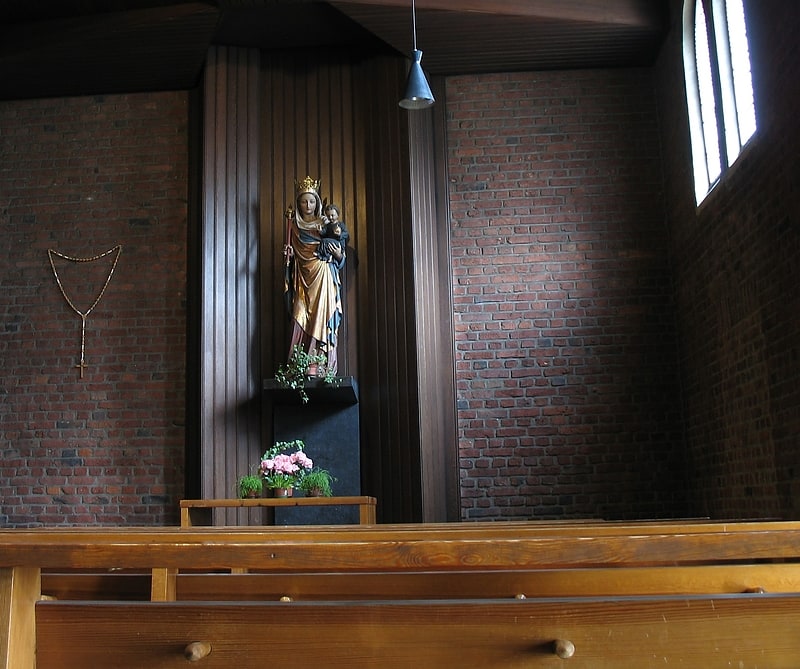
St. Josef in Aachen is a former Catholic parish church that is now used as a columbarium for urn burials under the name "Grabeskirche" (Church of the Holy Sepulchre), partly because the neighboring Aachen East Cemetery has reached the limits of its capacity.